TLDR:
If you have a stock or hybrid turbo you don’t need to be concerned that the “intake” portion of the Blaze ATOM Race V2 does not flow well. The restriction caused by the turbo inlet elbow (TIP) masks the reduced flow rate compared to other intakes.
If you have a turbocharger that can accept a 3″ inlet elbow (three inches at the outlet, or a 3″ silicone coupler), the Blaze ATOM Race V2 flows 23-30% less than the other aftermarket intakes I tested using a 3″ TIP.
Background:
A few days ago I made a post discussing results with the MGM7 Beta-2 intake and a surprising difference with the Blaze ATOM Race V2 intake.
In that post, I said I wasn’t going to look into the reason why, but curiosity got the better of me.
With the MGM7 Beta-2 being a part of my intake design project it represents a one-off product. Comparing the Blaze ATOM Race V2 with another commercial intake might be a better approach for determining the cause of the difference, or if there is one when compared to a “conventional” intake.
Apples-to-Apples:
The first step of this comparison was to address the Blaze intake outlet to the turbo. The Blaze design is similar to that of Revo and Turbo Technics, with a flange and silicone hose being used in place of the turbo inlet elbow.
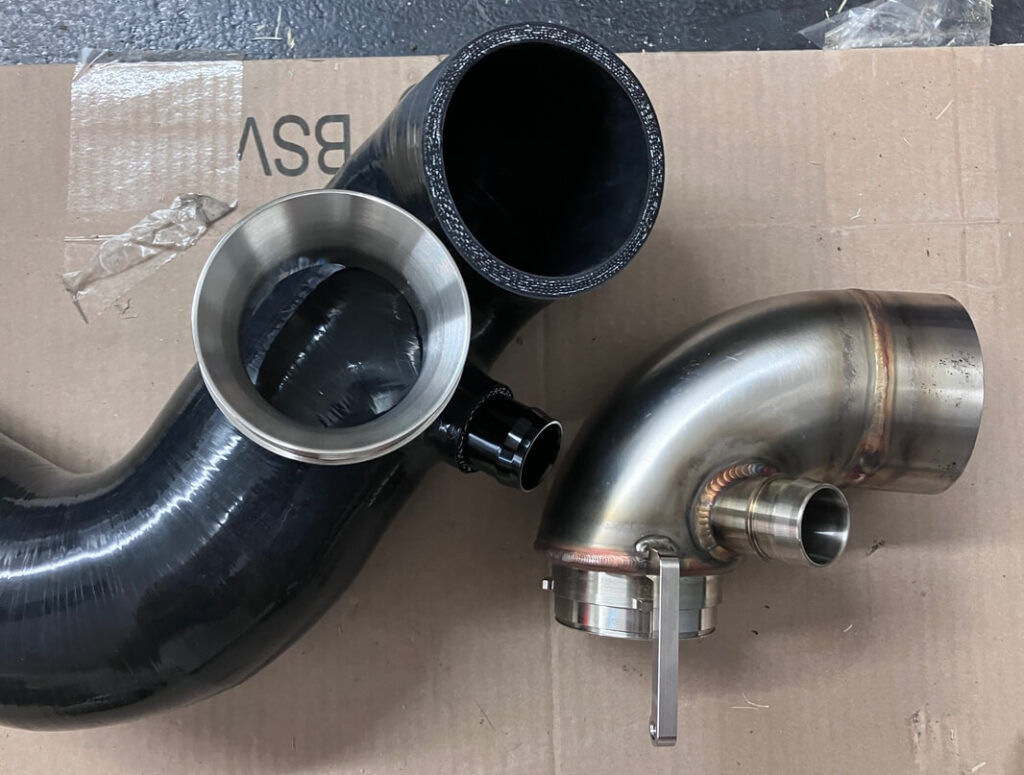
One configuration the Blaze setup supports is the silicone hose direct to the turbo. This eliminates the inlet flange, which is a significant source of airflow restriction and should allow the intake to support a higher airflow rate since the hose has a 76 mm inside diameter. (Far left image below).
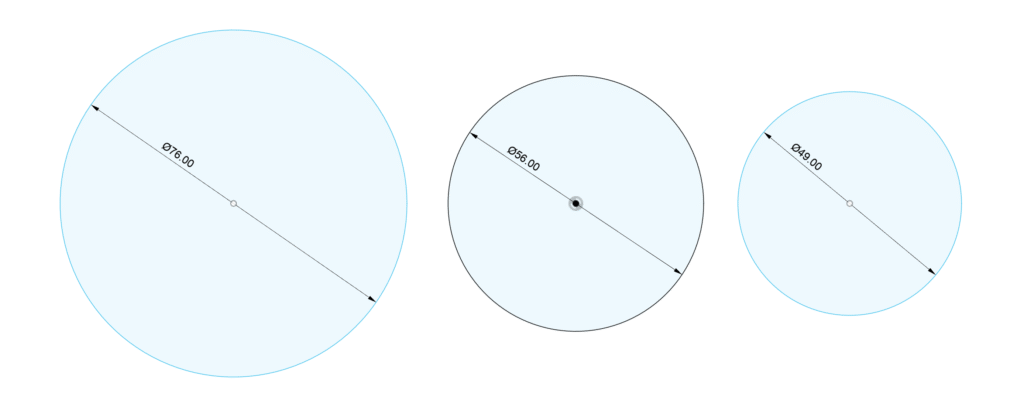
A challenge to making a fair comparison is that I am unaware of any turbo inlet elbows that have a 76 mm outlet. The most common stock-size elbows have a 49 mm outlet, and the rarer hybrid elbows, such as DBV2, do88, and MST, have an outlet of around 53-56 mm.
This is significantly less than 76 mm and would be a source of much restriction to any intake they are attached to compared to the 76 mm Blaze inlet hose.
To address this disparity in the outlet diameter I developed an inlet elbow that is 3″ at the inlet and 3″ at the outlet. This is shown next to the DBV2 TIP below.
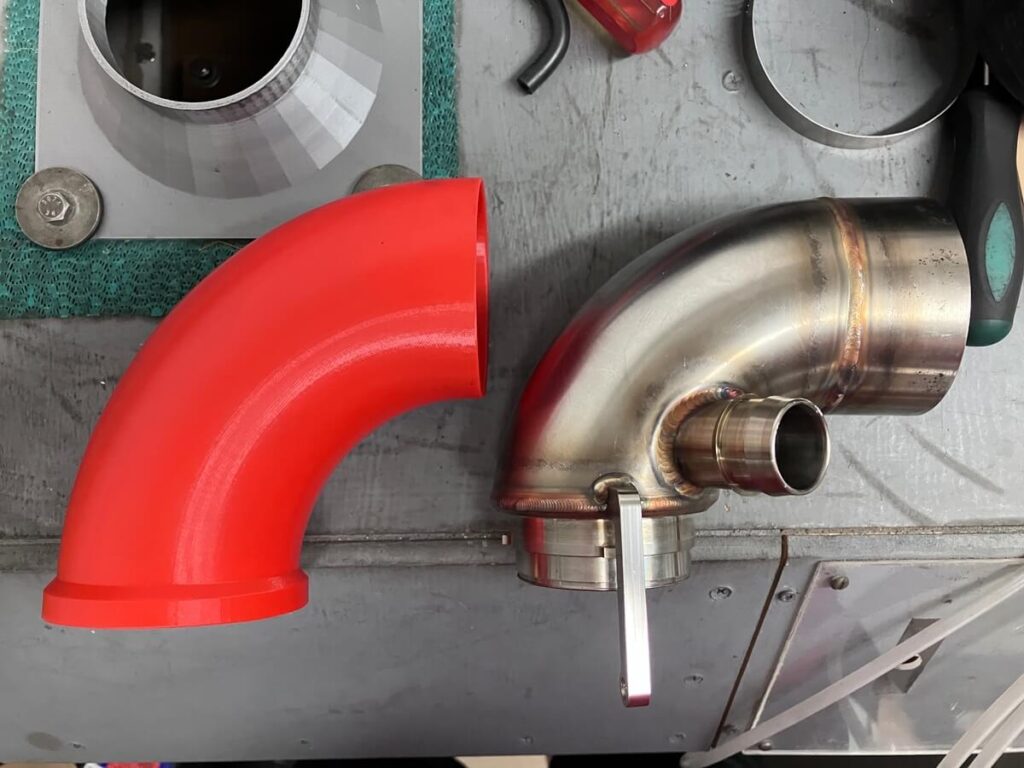
This elbow levels the playing field and allows for a comparison of the “intake” flow performance, rather than having the flow rate greatly skewed by the more restrictive hybrid-size elbows.
Comparison Products:
With the Blaze ATOM Race V2, minus the turbo inlet flange, as the baseline product, I chose the APR PEX intake as the comparison intake.
The PEX intake is easily attached to an MST turbo inlet hose, and the MST hose is the right size to attach to the 3″ inlet elbow.
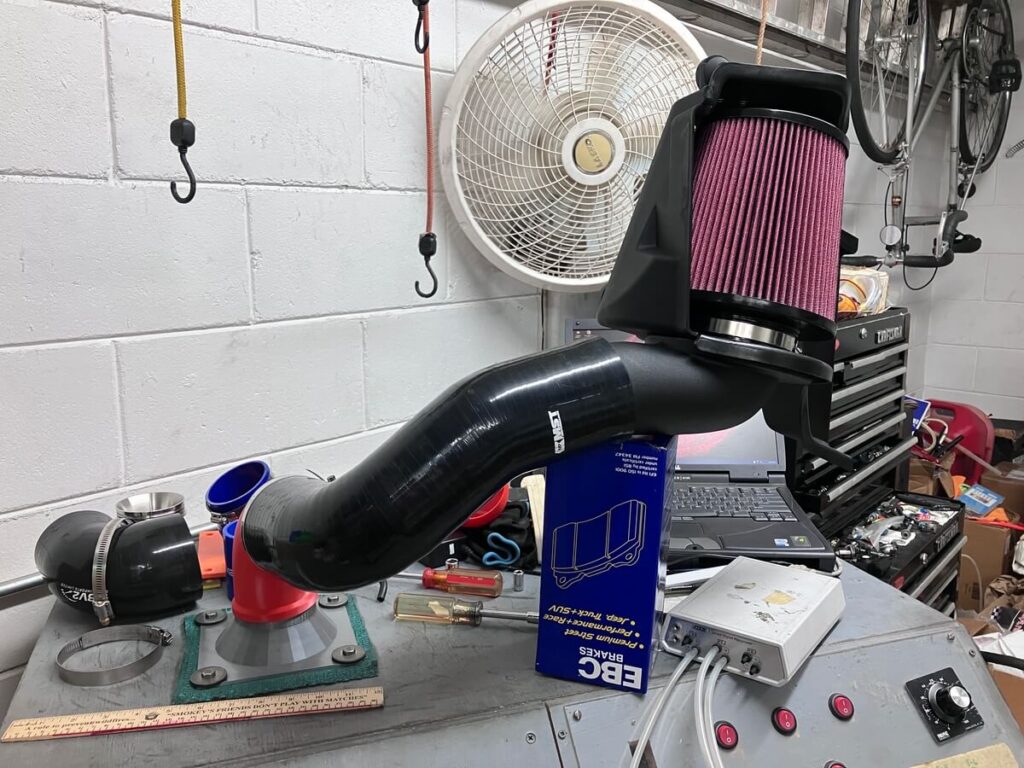
The APR PEX intake was measured at a pressure of 13″ of H2O, the same as with the Blaze intake, and produced a flow rate of 492 CFM.
This result is shown with the Blaze intake on the chart:
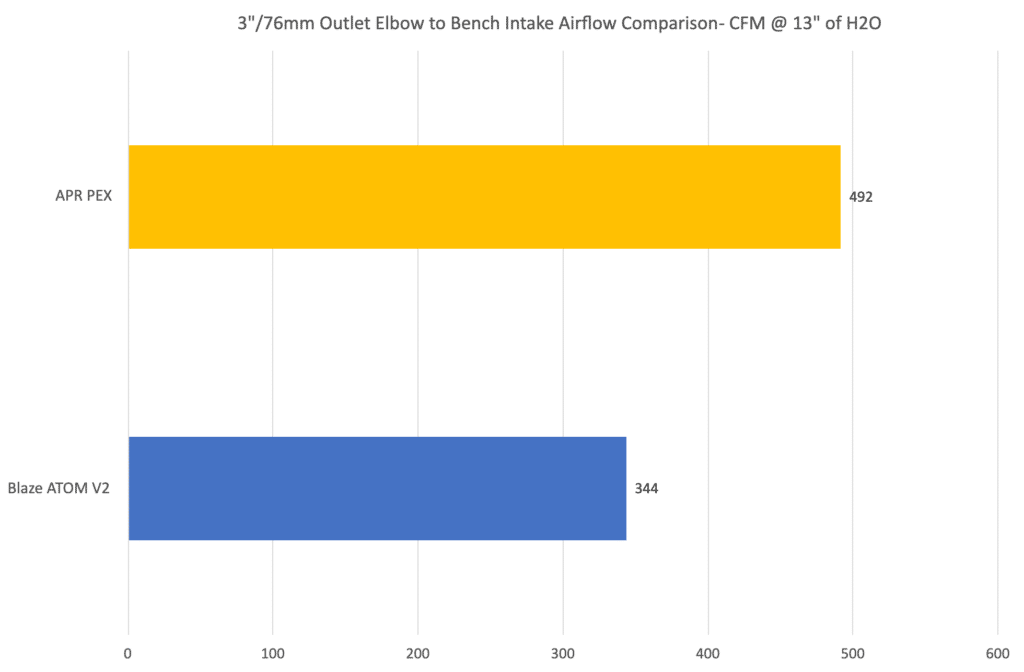
While not as large as the 63% difference with the MGM7 Beta-2 there is still a significant difference in flow rates. The APR PEX is flowing 43% more than the Blaze ATOM Race V2.
Note: There are a couple of other intakes in my garage that were tested for better trend analysis. The results of those tests are shown below:
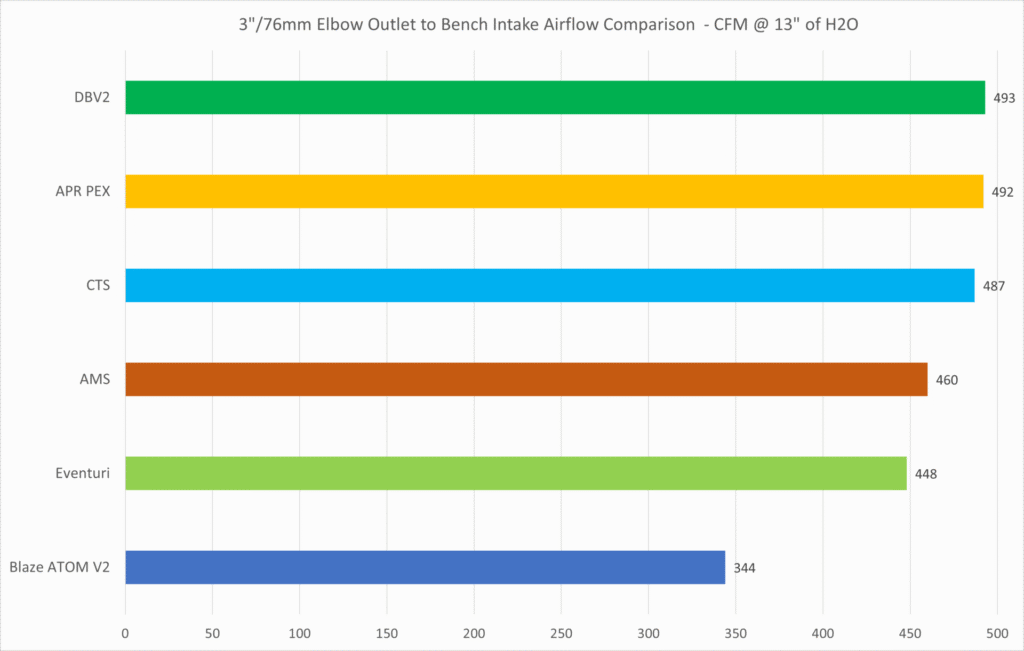
Next comparison:
Looking for a closer comparison I set up the GTI intake as close to stock as I could reasonably do. (I wasn’t going to try and tape over the driver’s side duct opening.)
The stock airbox is fitted with the “snow guard” and a used Mann air filter. The MST turbo inlet hose is used because the stock accordion would not fit onto the 3″ elbow.
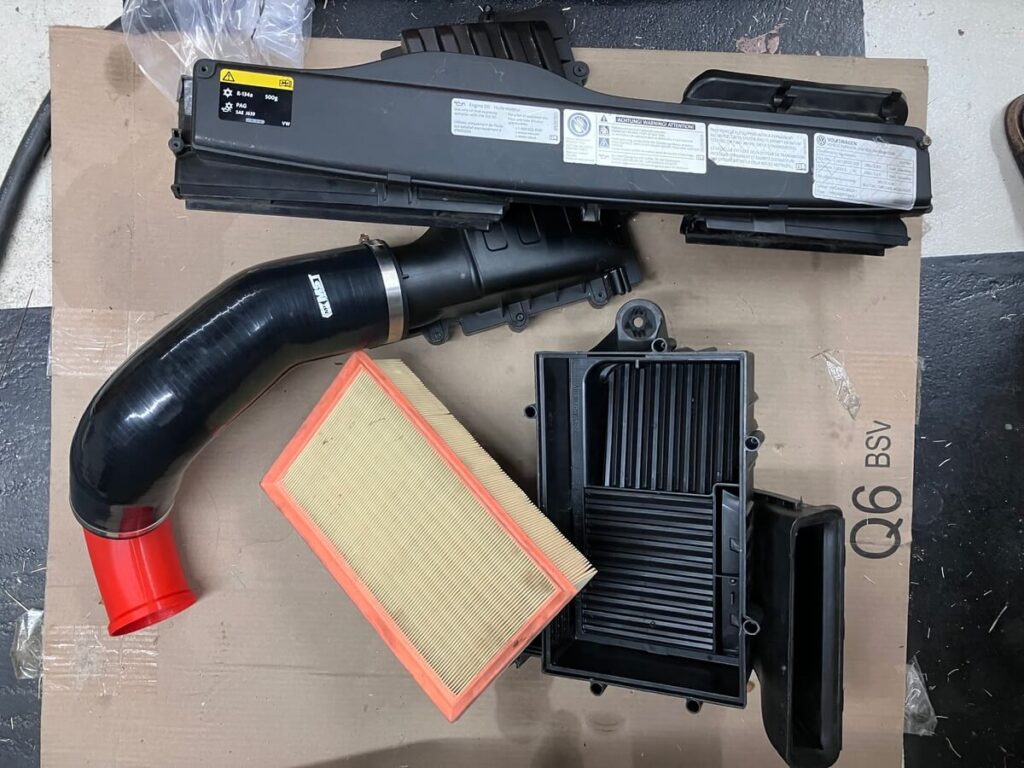
The intake is assembled and the duct is attached, then the system is attached to the flow bench.
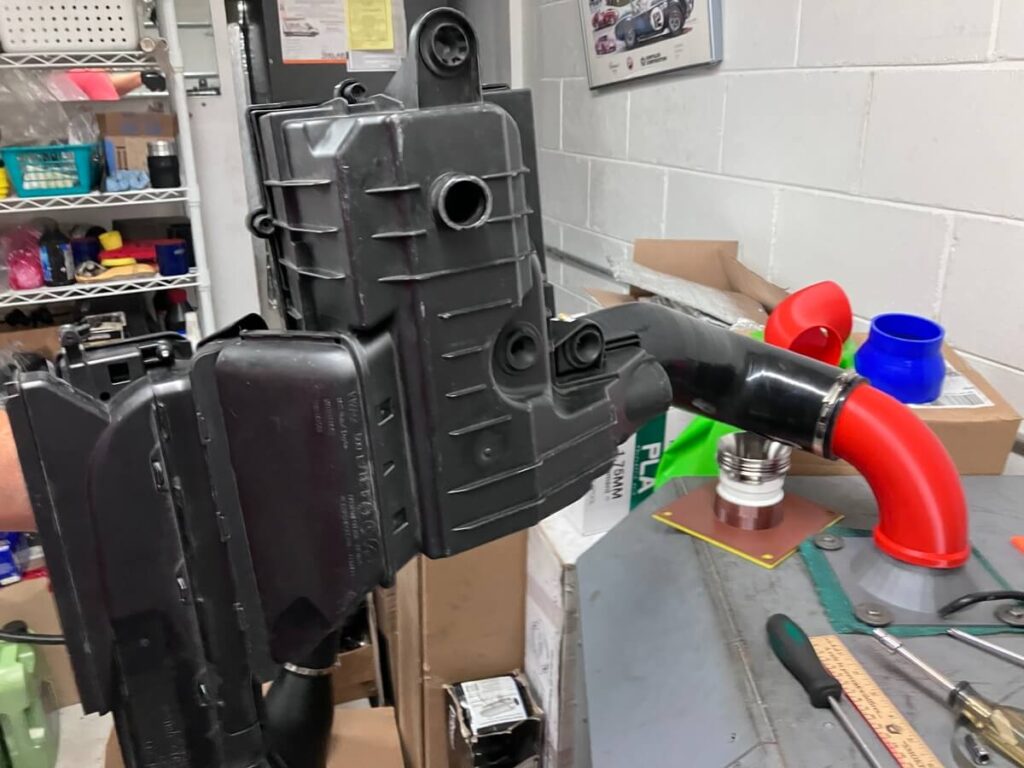
The stock intake flowed 373 CFM @ 13″ of H2O.
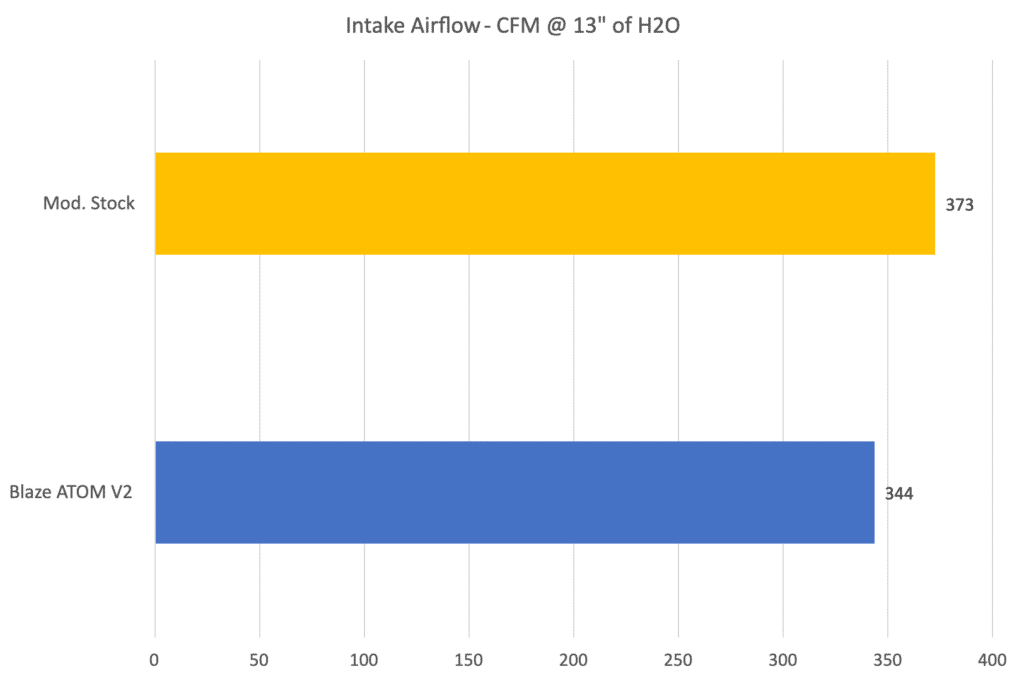
This was another surprising result compared to the flow rate the Blaze ATOM Race V2 generated. (I retested the Blaze intake half a dozen times over a couple of days to reassure myself that something odd hadn’t occurred.)
Component comparison:
From the previous session, I had hypothesized that elements on the inlet hose might be significantly contributing to the results, and to test that hypothesis I removed the airbox, air filter, and duct from each intake, leaving just the Blaze inlet hose, and the MST hose with the elbow.
Note: To keep the comparison fair the red elbow needs to be left on the MST hose since it accounts for a 90-degree bend, which is likely to be a significant source of pressure loss. The Blaze has two 90-degree bends, so the MST needs to have two 90-degree bends as well.
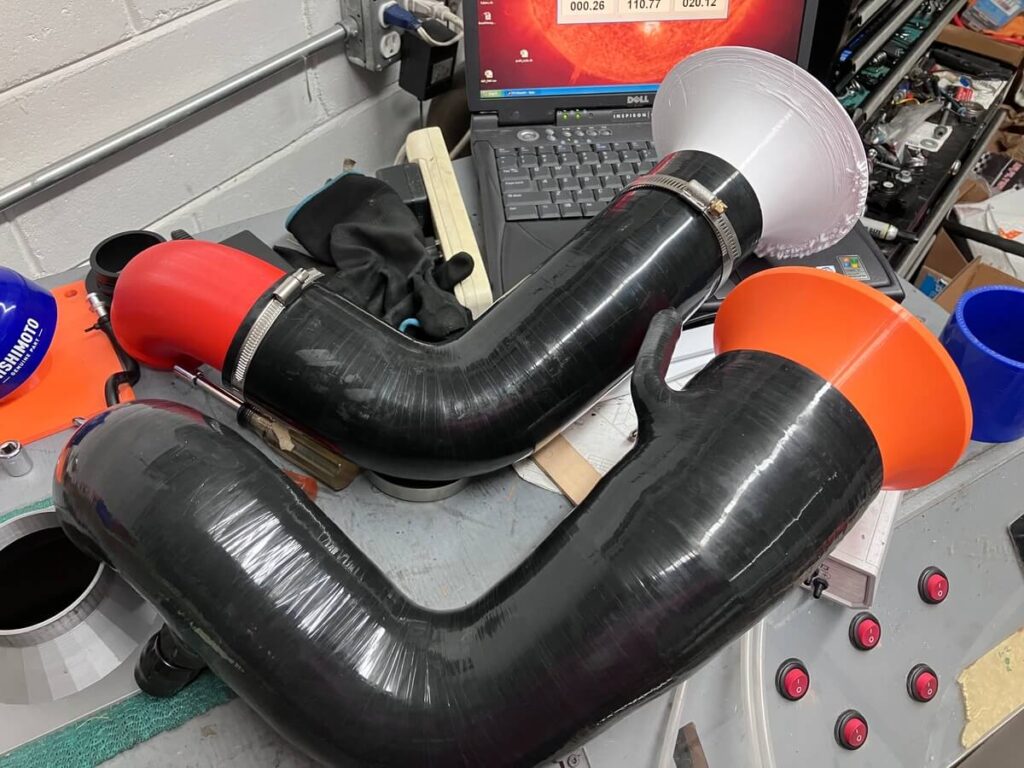
A bellmouth was placed in the inlet end of each silicone hose to facilitate a smooth entry of air into the hoses.
Both inlet hoses were measured at a pressure of 10″ of H2O.
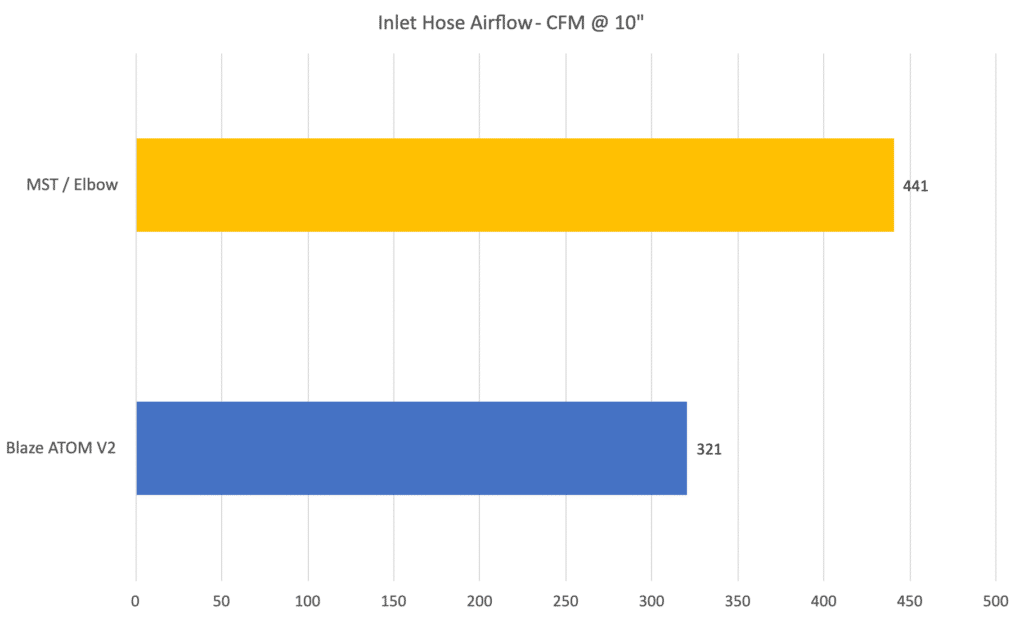
The MST/Elbow combination flowed 37% higher than the Blaze inlet hose, strongly pointing to the inlet hose as a significant cause of the flow rate difference between the Blaze ATOM Race V2 and the other intakes it was compared to.
Conclusions:
A previous flow test showed a very large difference in flow rates between the Blaze ATOM Race V2 and the MGM7 Beta-2 intake. The MGM7 flowed 91% more air than the Blaze intake.
In this post, additional testing was discussed that sought to understand the factors driving the difference.
A flow rate comparison was made between the Blaze intake and an APR PEX intake. This test showed the APR intake flowing 43% more than the Blaze intake.
Another comparison was made between the Blaze intake and a modified stock airbox. The modified stock airbox flowed 8% more than the Blaze intake.
A final comparison using only the inlet hoses and inlet elbow produced a 37% greater airflow from an MST inlet hose and 3″ TIP combination compared to the Blaze inlet hose. This result provides compelling evidence that the Blaze inlet hose is a significant factor contributing to the difference in flow rates measured during this testing.
The Blaze ATOM Race V2 intake flows substantially less (23-30%) than other aftermarket intakes tested.
Inlet Elbow Reminder –
It’s worth restating that a goal of this testing was to compare the “intakes“. For this test, the intake consists of the intake duct (if applicable), airbox, air filter, and turbo inlet hose.
Because the Blaze intake incorporates a bend that is typically found as part of a turbo inlet elbow an inlet elbow was made for this test. This inlet elbow has a 3″ inside diameter from the inlet to the outlet.
Inlet elbows are the smallest diameter component in the pre-turbo intake system and consequently have a significant effect on the overall intake flow rate.
For a stock or hybrid turbocharger the inlet elbow contribution to limiting flow rate dwarfs that of the intake. This means that the effect of the rest of the Blaze intake will not be noticed when the intake is used with a stock or hybrid turbocharger.
If an intake is being considered for use with a turbocharger that allows a 3″ inlet, the Blaze ATOM Race V2 flow rate is greatly exceeded by the APR PEX and other aftermarket intakes, as well as by a modified stock intake.
Note: Removal of the stock airbox “snow guard” corresponds with an airflow increase from 373 CFM to 398 CFM.
Reconciling with “what I’ve heard“:
So you’ve heard the Blaze ATOM Race V2 intake is the best in the world for the Mk7 and don’t understand how these measurements can be accurate.
Whatever comparison you heard about was most likely of a setup that uses a stock or hybrid turbo inlet elbow (TIP). See the Inlet Elbow Reminder above.
In this test, the goal was to limit the contribution of the inlet elbow so a comparison of the intakes could be made (airbox, air filter, air duct, inlet hose).
Whatever “real-world” example you heard about, where the Blaze intake resulted in improved performance, the turbo inlet elbow was almost certainly the determining factor of the performance change.
Most likely, a change was made from a stock-sized turbo inlet component to a hybrid-size inlet component, as that has been the case for every “real-world” example I have seen (see links in references below).

Now you know the rest of the story
Paul Harvey
References:
- MGM7 Beta-2 Flow Test
- Blaze Real World Data – Check #1
- Blaze Real World Data – Check #2
- Blaze Real World Data – Check #3
- Blaze Real World Data – Check #4
- Blaze Real World Data – Check #5
- Blaze Real World Data – Check #6
Censoring:
This is a topic worthy of its own discussion, but in the interest of expediency, I’m posting it as an addendum here.
I’ve observed a decent amount of censoring of information on social media channels. Information posts that I have made disappear a short time later, and in some cases, after posting a link to information such as what is shown above, my account is removed from a Facebook group.
This morning I made a post on the Mk7 GTI Owner Facebook group.
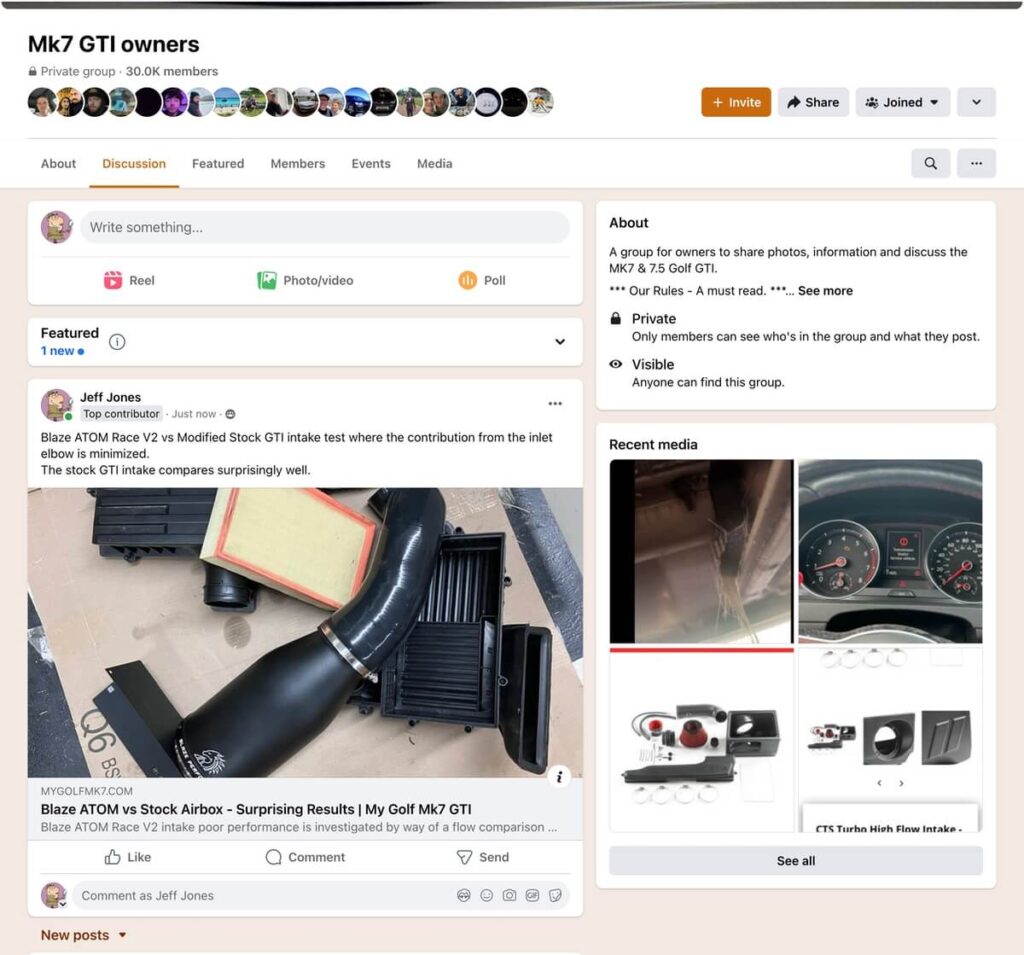
Less than two hours after making the information available at 8:23 AM the post disappeared:
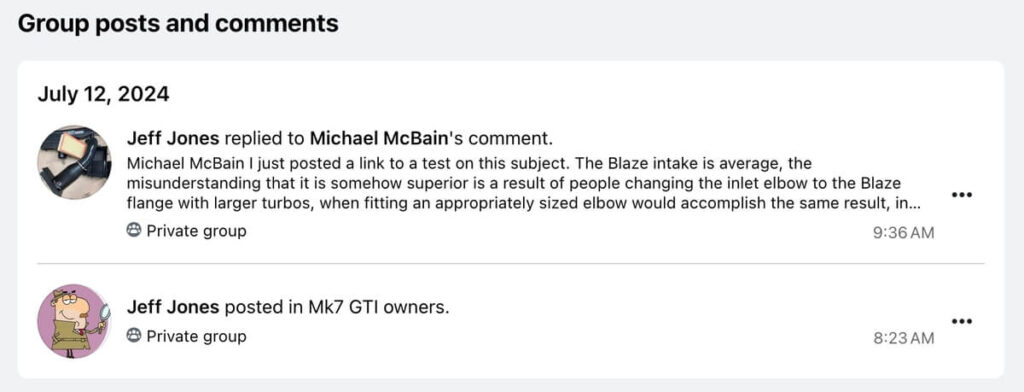
Coincidentally, an example of how misinformation can spread when facts are censored was made in the group at the same time.
In the example below, Michael thinks his Blaze ATOM intake will flow enough to support any turbo.
Although the Blaze intake isn’t likely to stop the passage of air, it does cause a decent amount of pressure drop compared to other options, which will drive up the turbocharger’s wastegate duty cycle.
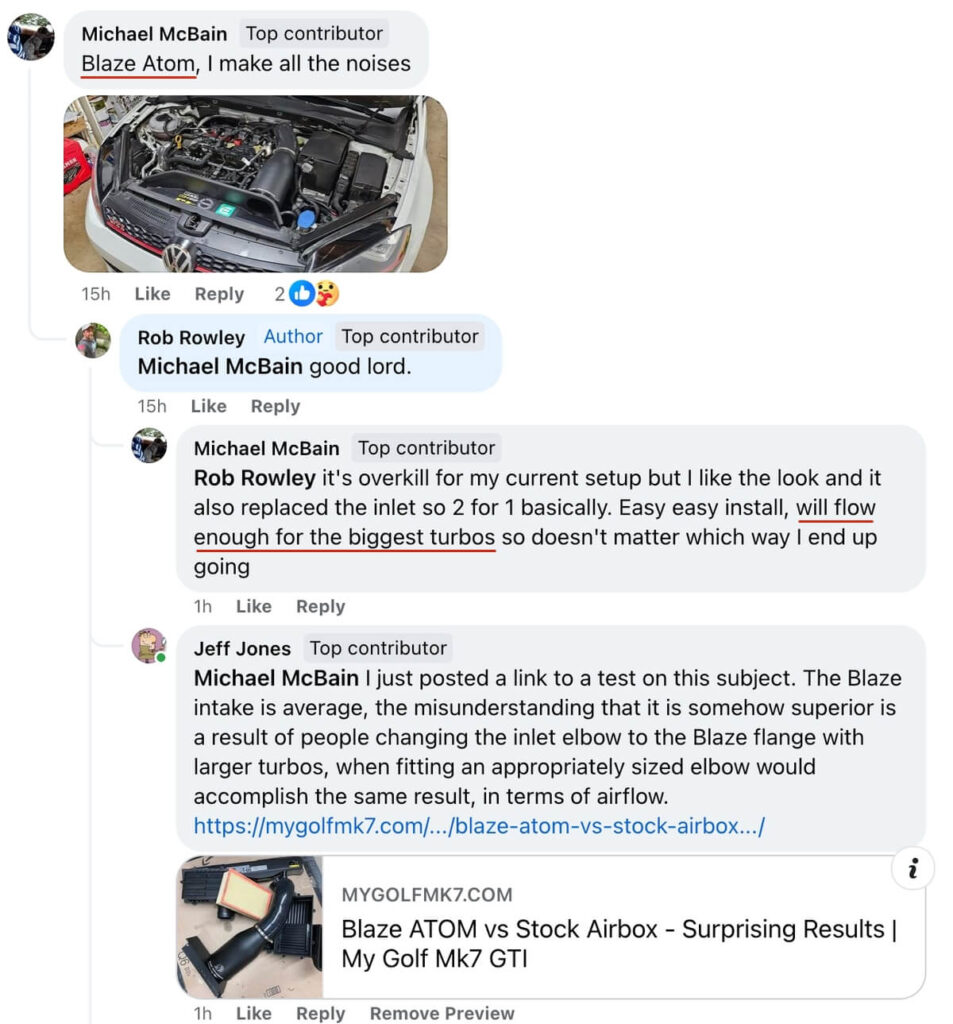
Thanks to an Administrator or Moderator on the Mk7 GTI Owners group, information about how the Blaze ATOM intake performs is no longer accessible to the group members.
I suggest other owners provide a link to this post to help make the information available.
Blaze Post $$$ Deal
Follow the link to learn about a test to see how bad censoring of this information is, and potentially earn a reward for posting a link to the results.

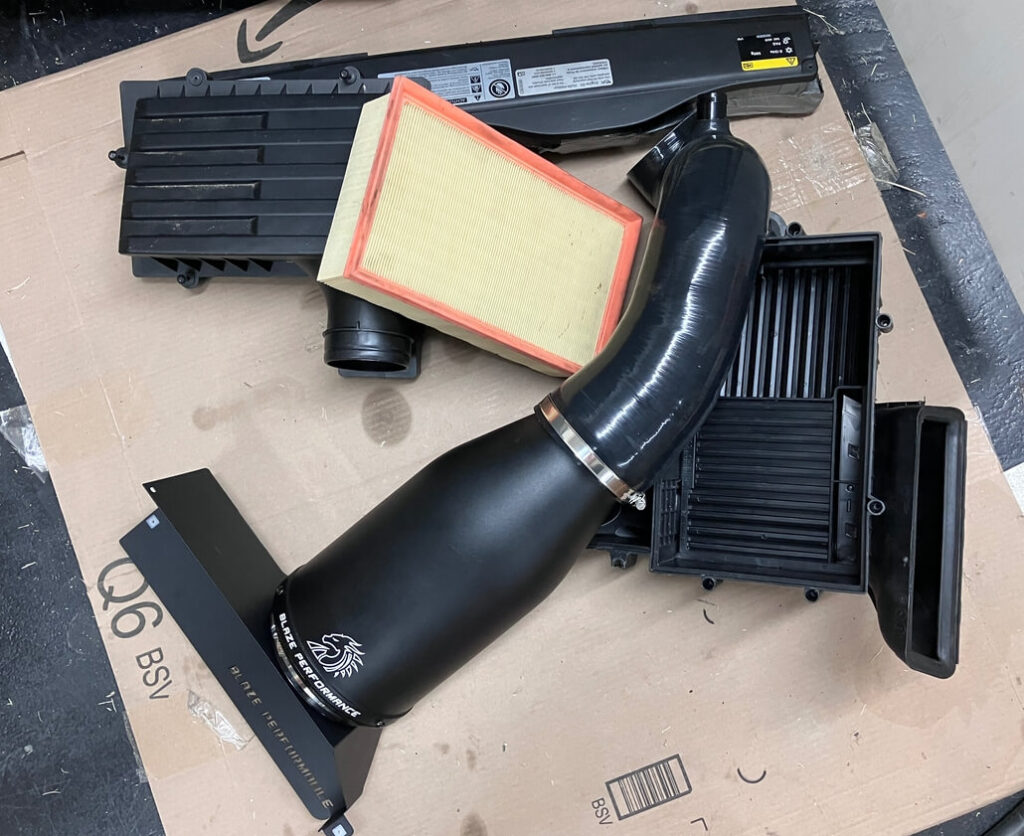
Nice work/testing here. Yes, the amazing improvments being reported by some including WG duty cycle values that show the drop in restriction always have been b/c the user also changed out the TIP which of course/as your testing shows, is the actual source of the improvement. This key point seems to be missed by the masses…
Yes. It doesn’t help that the vendors of the products have failed to disclose the important contribution of the elbow and speak in terms of swapping the intake.
Using your flow tests I went with the 034 inlet elbow and the Apr open pex intake with a custom silicone hose which was better value and performance over the blaze intake.
Thanks for your work!
You’re welcome!
So very odd two pipes which are basically the same looking flow very different. Only difference I can see is the MST doesn’t have as sharp of a 90 degree bend as the blaze. Plus the blaze has two port barbs. This is the only two thing I can see that would affect flow between the two? Considering the blaze is a 4” pipe aswell tapering to 3” very hard to wrap your head around the why here..
The sharpness of the bend factors into determining the resistance factor of the bend. Looking at the ratio of the centerline radius to the pipe diameter the resulting value can be used in a lookup table to determine what the resistance factor is, which is analogous to coefficient of drag for a car body. An approximate measurement put the Blaze resistance coefficient around 0.43 and 0.46 for the first and second bends. The MST and red elbow combination are about 0.33 and 0.30. This coefficient is multiplied by the square of the average airflow velocity, so inherently the Blaze pipe bends will cause more pressure loss.
Hey Jeff
Thanks for the science behind it. Yeah it makes sense with the bends not helping flow.
Does the CTS intake and the DBV2 TIP have LHD & RHD variants like the blaze intakes do?
Blaze RHD intake pipe looks much better then the LHD version. I feel the RHD 4” blaze intake pipe with an open filter on the end will flow very well as a whole intake..
Cheers
I’m not aware of either supplier offering products for RHD vehicles, but I also don’t know what would be different about them. The only experience I have with RHD parts is the Blaze inlet hose. The Blaze RHD version did flow a good bit better than the LHD version when I measured them.